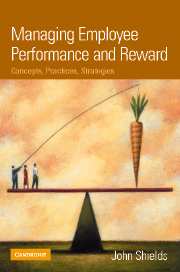Book contents
- Frontmatter
- Contents
- List of figures and tables
- Foreword by John Egan
- Acknowledgements
- Introduction: Setting the scene
- Part 1 The fundamentals
- Part 2 Performance management in action
- Part 3 Base pay and benefits
- 9 Base pay purpose and options
- 10 Base pay structures
- 11 Developing position-based base pay systems
- 12 Developing person-based base pay systems
- 13 Employee benefits
- Case study. Just rewards: Rethinking base pay and benefits at Court, Case & McGowan, commercial law partners
- Part 4 Rewarding employee performance
- Part 5 Fitting it all together
- Model responses to case studies
- References
- Index
10 - Base pay structures
from Part 3 - Base pay and benefits
- Frontmatter
- Contents
- List of figures and tables
- Foreword by John Egan
- Acknowledgements
- Introduction: Setting the scene
- Part 1 The fundamentals
- Part 2 Performance management in action
- Part 3 Base pay and benefits
- 9 Base pay purpose and options
- 10 Base pay structures
- 11 Developing position-based base pay systems
- 12 Developing person-based base pay systems
- 13 Employee benefits
- Case study. Just rewards: Rethinking base pay and benefits at Court, Case & McGowan, commercial law partners
- Part 4 Rewarding employee performance
- Part 5 Fitting it all together
- Model responses to case studies
- References
- Index
Summary
Having considered the general differences between position-based and person-based options, we can now turn to the more technical aspects of managing base pay systems. In this chapter we investigate options for structuring base pay. As we shall see, approaches based on the job, skills or competencies each have their own distinct structures and modes of pay progression. As well as coming to terms with these ways of structuring base pay, following the tenets of a ‘best fit’ approach to system design, we also seek to identify those organisational settings and management strategies for which each of these alternative structures might be most (and least) appropriate. Chapters 11 and 12 will then examine the steps involved in developing, implementing and maintaining position- and person-based systems.
Two considerations are crucial to the design of any base pay system. First, what will be the system's overall form or ‘structure’? Second, within this structure, what will be the ‘rules’ that determine how and by how much each employee's base pay changes or progresses over time? Since the question of progression is necessarily subordinate to that of structure, it is appropriate that we begin by discussing the latter.
What, exactly, is a base pay structure? In essence, it is the ‘architecture’ of the base pay system. A base pay structure has three main purposes. First, it specifies categories or classifications to which particular jobs and job-holders are assigned. Second, it specifies either the exact pay rate applicable to each position or a pay range (i.e. the minimum and maximum pay rates) for each category.
- Type
- Chapter
- Information
- Managing Employee Performance and RewardConcepts, Practices, Strategies, pp. 249 - 268Publisher: Cambridge University PressPrint publication year: 2007

